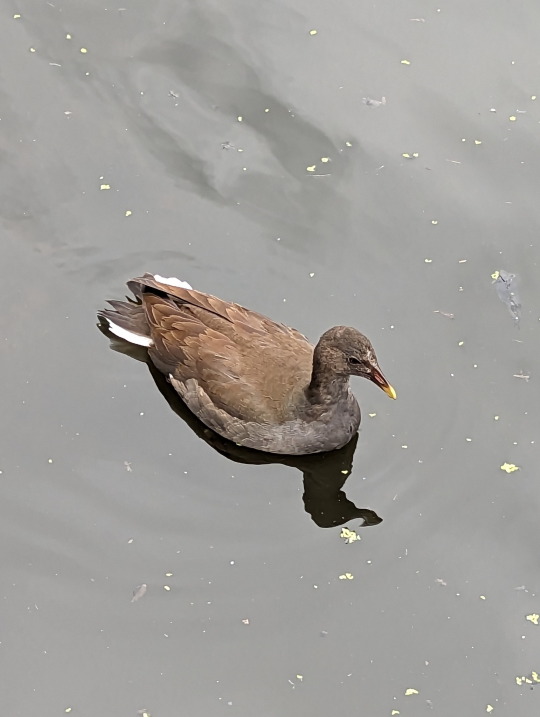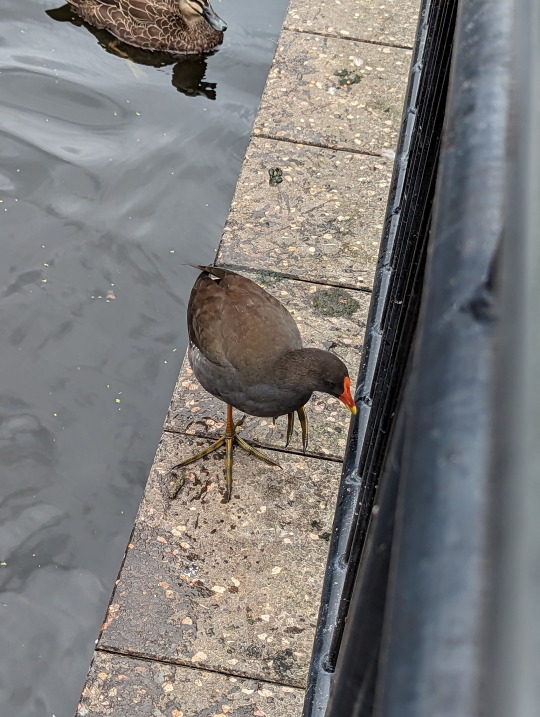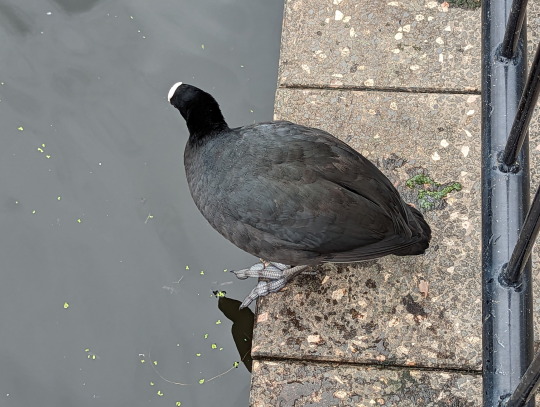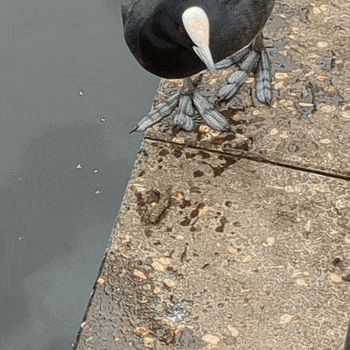#porphyrios
Text
Porphyrios

Since 2020 there have been over 400 run-ins with orca whales off the coast of Spain. So far, they've sunk at least three ships and damaged dozens more. A ship's skipper, Daniel Kriz, who has had the orcas damage rudders on two different boats he's been on, says they're getting better at it too.
“In 2020, the attack lasted almost an hour and was not as organized,” Kriz said. “This time we could hear them communicating under the boat. It only took about 10 to 15 minutes.”
Why are whales suddenly going after boats with such determination and for such a long span of time? Scientists are unsure, leaning between the whales retaliating for harm a ship did them previously or simply becoming brave enough in their curiosity to unintentionally damage ships. Perhaps I am a bit too influenced by stories I've read but I would tend to believe the orcas know exactly what they're doing.
I also know this isn't the first time a whale has attacked, or sunk, a ship.
Perhaps the most modern famous one is the sperm whale that sunk the whaling vessel Essex in 1820, an incident that inspired Herman Melville to write Moby Dick in 1851.
But we can go further back than that.
Much further.
Let's go back to sixth century Constantinople. According to Procopius, a historian of the time from Caesarea, a great whale, 45 feet (13.7 meters) long and fifteen feet (4.6 meters) wide haunted the Strait of Bosporus and the waters around it. This whale wasn't just there to sight-see either. The whale attacked and sank ships it came across.
The sailors of the time named the monster Porphyrios.
There's debate what the name was derived from (other than the gut kick reaction to shout 'oh shit!' the second you saw the whale hove into view) but most scholars think the whale's name came from prophyra which meant a deep, purple color. This could have been referring to the color of the whale's skin or perhaps imbuing it with some of the terrifying, regal nature that nobles of the time, the only ones allowed to wear the purple, implied. Whales weren't well known in that area of the world at that time and we have no way of knowing what kind of whale it was. Speculation based on size leads many to believe it was a lost sperm whale a long way from home but it might have also been a large orca. Iberian orcas hunt the Straight of Gibraltar, following the bluefine tuna every year and they're the ones responsible for the recent ship attacks off the coast of Spain of the past few years. It's not hard to imagine one of them wandering east, deeper into the Mediterranean Sea, instead of heading back north when the tuna left. And Porphyrios didn't just set up shop anywhere. He decided that the Strait of Bosporus was his new hunting ground.
Here's the thing. The Strait of Bosporus was the main trade route for that part of the world. Goods flowed down to the Black Sea, crept through the narrow Strait of Bosporus which let out into the Sea of Marmara. One more strait, this one the Dardanelles, where the city of ancient Troy once controlled all trade out of the East, and then it was out into the Aegean Sea and then on to the Mediterranean. Trade goods could pass by on land but it added both dangers and time to the business and, most importantly, took all that sweet, sweet toll to use their water passage right out of Constantinople's hands. Having what amounted to a sea monster living in their main money-maker and convincing merchants to find other ways to bypass the strait, and therefor the city sitting on the edge of it, was disastrous for a country that was trying to restore itself to its former glory. Emperor Justinian I, also known as the Great, put out a bounty on the monster's head and did everything in his power to encourage its capture or eradication.
The tools of whaling used centuries later to drive many whale populations to the brink of extinction however were unknown at the time. Porphyrios shrugged off the arrows and spears lobbed at it and went on sinking ships, sending simple fishing vessels to the bottom of the ocean just as steadily as it did merchant and war ships. There was even a story that Justinian's famous general, Belisarius, loaded a catapult onto a ship to hunt the deadly whale, though this seems to be just a story and one which also failed to killed the great monster of the strait.
Porphyrios becoming a terror that merchant captains probably saw in their nightmares even when they were on dry land. Long routes far out of the way were taken to avoid waters he swam in. There would be lulls. For unknown reasons, Porphyrios would disappear for long periods of time, lulling ship captains and their crews into thoughts that the monster had died. It never lasted though and for over fifty years, Porphyrios hunted the ships of the Bosporus and its surrounding waters, damaging some and sending many more to the bottom of the ocean.
Nothing lasts forever though. One day, the story goes, Porphyrios was chasing dolphins in the Black Sea and ran aground. Struggling to get back to deeper water, it only churned up the dirt, sinking itself more completely into the mud. Locals that lived nearby saw what was happening and ran out to kill the great beast but their axes did little damage against its tough hide. In the end, they lashed ropes to to the whale and, using horses and wagons, dragged its great bulk to higher ground. There they finally managed to kill the beast, eventually hacking it to bits and eating the pieces. Porphyrios, killer of men and sinker of ships, terror of the Bosporus, was no more.
It was the first recorded case of a whale attacking ships.
It hasn't been the last.
Perhaps the Iberian orca, social animals that can teach each other how to disable and sink ships, tell stories, late at night when they rest in the waters off the coast of Spain, with the bright lights from the shore twinkling above the water like electric stars. Perhaps they tell stories of an ancestor who hunted strange waters -
and taught the humans in their noisy ships above what real fear was.

#porphyrios#whale#whales#orca#sea monster#history#constantinople#justinian#killer whales#orcas#turkey#bosporus strait
10 notes
·
View notes
Video
youtube
15 notes
·
View notes
Photo

Today we celebrate our Venerable Father Porphyrios of Kafsokalyvia. Elder Porphyrios was born in 1906 in Euboea to pious parents. He worked as a shepherd boy when he was eight years old and came across a booklet about Saint John the Hut-Dweller which he read with great difficulty as he was uneducated. Deeply touched by the life of the saint, at twelve years of age, he secretly left for the Holy Mount Athos. Here, he met his spiritual father who guided him until his own repose. After some time, he had to return to Euboea because of illness. Here, at 18 years of age, he met the Archbishop of Sinai, Porphyrios III who beheld the depth of spirituality of the young monk and his already apparent gift of clairvoyance, ordained him a priest at the age of 20. Throughout his life, Saint Porphyrios would spend much time in the world, especially Athens, treating the patients of hospitals through his prayers and wonderworking. He lived to be an exemplary paradigm for asceticism in the world. The saint, however, did not discriminate. He would visit the sick, the healthy, the rich, the poor, the righteous, and the sinners, even preaching Christ at brothels, inviting the prostitutes to venerate the Holy Cross when he went around for house blessings. Sensing the end of his life, he retreated to Mount Athos once again where he stayed in Kafsokalyvia, the same kalyve where he had been tonsured a monk seventy years prior. The Saint reposed in peace, and by his instruction, his body was buried in an unknown location, thus his relics are unavailable for veneration. A pious doctor of the Saint, however, visited Sydney, Australia, and brought with him a vile of a blood sample he had from the elder, and thus our very own country has been sanctified with the presence of the Saint. May he intercede for us all + #saint #porphyrios #elder #elderporphyrios #woundedbylove #mountathos #athos #kafaokalyvia #ascetic #asceticism #monk #monastic #tonsure #ordination #priest #archbishop #sinai #mountsinai #mtsinai #mtathos #love #prayer #rich #poor #righteous #saintjohn #stjohn #shepherd #orthodox #saintoftheday (at Athens, Greece) https://www.instagram.com/p/Clo0tpFrPp3/?igshid=NGJjMDIxMWI=
#saint#porphyrios#elder#elderporphyrios#woundedbylove#mountathos#athos#kafaokalyvia#ascetic#asceticism#monk#monastic#tonsure#ordination#priest#archbishop#sinai#mountsinai#mtsinai#mtathos#love#prayer#rich#poor#righteous#saintjohn#stjohn#shepherd#orthodox#saintoftheday
21 notes
·
View notes
Photo

why he ourple??
#Dungeons and Dragons#dnd#dnd character#dnd fighter#dnd dragonborn#purple dragon#porphyrios#porph#circartry#made an icon for his character sheet :)#also just kinda fiddling around with krita as well#i like this brushes texture
20 notes
·
View notes
Text
Why can’t I be a whale harassing Byzantine sailors
9 notes
·
View notes
Note
Hi! i was hoping for some help on finding a fic. Drarry is older and they're married but they're having some issues so they go on a vacation i think it's to egypt but i could be wrong and harry thinks draco is going to break up with him but draco just wants to fix things. it does have a happy ending though. Thank you !
We believe you're looking for Together by Porphyrios (9k, G)
Don’t forget to bookmark, leave kudos and comments!
5 notes
·
View notes
Text
youtube
An Ancient Terror at Sea: The Mysterious Whale That Hunted Ships of the Roman Empire
A formidable creature lurked in the treacherous waters of the 6th-century Eastern Roman Empire, far surpassing mere myth. Porphyrios, a colossal whale, not only haunted the nightmares of Byzantine sailors but also caught the attention of Emperor Justinian the First himself.
Although the precise origins of the beast’s name are unconfirmed, some argue it's a nod to Greek or Roman-Byzantine mythology, referencing divine beings or towering giants.
Others suggest a more literal interpretation, inspired by the creature's dark, purple-tinted skin, reminiscent of the royal purple garments synonymous with Byzantine royalty. This hue was described as 'inky' by witnesses.
Another translation of the name equates to 'purple boy.'
Porphyrios was known to attack ruthlessly and indiscriminately, taking the lives of soldiers, fishermen, and merchants and destroying numerous Byzantine vessels.
Eyewitness accounts of the vast creature claim that Porphyrios measured 45 feet long and 15 feet wide, suggesting that it may have been a sperm whale, which would also explain its aggressive nature and how it managed to live long enough to terrorize so many ships.
With almost no natural predators, sperm whales can live remarkably long. Incredibly, Porphyrios' reign lasted more than fifty years, during which, according to Procopius, an eyewitness and Greek scholar, he, quote, "sank many ships and terrified the passengers on many others, diverting them from their course and taking them great distances."
#history#historical mystery#whales#roman empire#Youtube#porphyrios#byzantine#byzantium#eastern roman empire
0 notes
Text

Grey-headed Swamphens (Porphyrio poliocephalus), raising a ruckus, family Rallidae, order Gruiformes, Vembanad Lake, India
photograph by Agasty Roy Arpita
1K notes
·
View notes
Text

Notecard for scale
My enormous new roommate I guess. Pattern was for a baby humpback whale but I used a much girthier yarn and ended up with a full grown humpback whale
I’m so obsessed we share a bed now
#who needs a body pillow#crochet#amigurumi#whale#fiber arts#plushy#my art#i dont really name things consistently and my favorite whale is Porphyrios but that means Purple Boy and this isnt purple#took 40 oz (two large bags) of polyfill to stuff it
254 notes
·
View notes
Text


Gruiformes: Porphyrio melanotus


Gruiformes: Gallinula tenebrosa


Anseriformes: Anser anser domesticus × anser cygnoides domesticus


Anseriformes: Chenonetta jubata


Gruiformes: Gallinula tenebrosa


Gruiformes: Fulica atra, note the wacky feet


Anseriformes: Anas superciliosa ssp. superciliosa


Charadriiformes: Chroicocephalus novaehollandiae


Columbiformes: Ocyphaps lophotes
Various southern bird life, and some GIF footage.
25/03/23 - Aves spp. - Wollongong, urban botanical garden
#Porphyrio melanotus#Australasian Swamphen#Gruiformes#Aves#Birds#birbs#birblr#birdlr#Anseriformes#Anser anser domesticus × anser cygnoides domesticus#Domestic Greylag × Domestic Swan Goose#Waterfowl#geese#Chenonetta jubata#ducks#Australian Wood Duck#Fulica atra#Eurasian Coot#Coots#Anas superciliosa ssp. superciliosa#Pacific Black Duck#Chroicocephalus novaehollandiae#Silver Gull#Charadriiformes#Ocyphaps lophotes#Columbiformes#Crested Pigeon#pigeons#vertebrates#gifs
381 notes
·
View notes
Text

A grey headed swamphen (Porphyrio poliocephalus) searches for food amongst the marshes in Bundala National Park, Sri Lanka
by Timo Hannukkala
#grey headed swamphen#swamphens#rails#birds#porphyrio poliocephalus#porphyrio#rallidae#gruiformes#aves#chordata#wildlife: sri lanka#wildlife: asia
158 notes
·
View notes
Text

One day in Athens, Saint Porphryios was with a nun and needed to take a taxi. The taxi driver they found was an uncouth, blasphemous character. So the nun said to Saint Porphryios: "Maybe we should find another taxi." But he replied: "No, let's go with this one, but let me do all the talking."
When they got in the taxi, the taxi driver started saying all kinds of things to them about how selfish priests are, how corrupt bishops are, etc. Saint Porphyrios didn't say a word, and so neither did the nun. After going on and on for quite some time, the taxi driver started wondering why the priest and nun weren't responding. So he looked back at them and said: "So, priest, what do you have to say about all this I've said?"
Saint Porphyrios replied: "Well, let me tell you a story. There was once a very good priest in Crete whose wife had died and was living alone with his young son. But then the Nazis came and killed this priest. His son couldn't understand how God would let this happen to such a good person, and so he became very embittered and angry with God."
At this point, the taxi driver stopped the car and in tears said to Saint Porphyrios: "But, Father, that is my story." After this, the taxi driver confessed to St. Porphyrios and began to live a spiritual life.
+ From the journal of Hieromonk Ephraim
#Saint Porphyrios#st. porphyrios of kavsokalyvia#panagia’s garden book club#eastern orthodox#eastern orthodoxy#orthodoxy#orthodox christianity#orthodox#christianity#greek orthodox
150 notes
·
View notes
Text

American Purple Gallinule
146 notes
·
View notes
Photo


Porphyrios, Fixer of All Problems Eternal. theres no better drake for whatever worriments, botherations, or vexations disquiet you!
no YOU need to stop making dragonborn fighters!!
#Dungeons and Dragons#dnd#dnd character#dnd fighter#dnd dragonborn#purple dragon#porphyrios#porph#character ref#circartry#hes based off a monitor lizard :)#IM finally playing the adult in the room HA#cant wait to play more of porph hes such a weirdo <3#and what can i say dragonborn fighters are simply the most fun thing to play
19 notes
·
View notes
Photo

Grey-headed swamphen (Porphyrio poliocephalus) chick at the Wakodahatchee Wetlands in Florida, U.S.
Pedro Lastra
1K notes
·
View notes
Text




The Western Swamphen, the largest rail bird I have ever seen.
27 notes
·
View notes